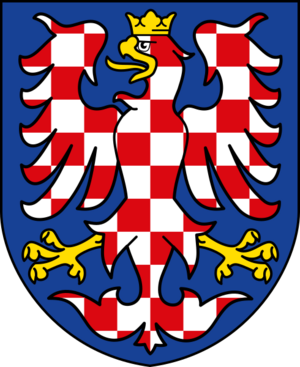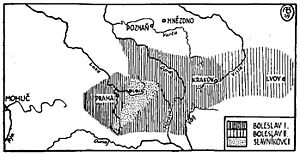History of Moravia facts for kids
The history of Moravia is a long and exciting story. Moravia is a region that is part of the Czech Republic today. Its past is full of changes, with many different rulers and important events shaping its identity.
Contents
Early Times: Prehistoric Moravia
Long, long ago, even before recorded history, people lived in Moravia. Early modern humans settled here during the Stone Age. One famous place is the Předmostí archaeological site. Scientists believe people lived there about 24,000 to 27,000 years ago.
Ancient Moravia and Great Moravia
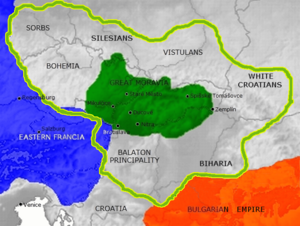
Around 60 BC, a group called the Celts left Moravia. Then, Germanic tribes, like the Quadi, moved in. Later, in the 6th century AD, Slavic tribes arrived. These Slavic people settled down in the area.
By the late 700s, a new state began to form. It was called the Moravian Principality. This principality grew bigger in 833 AD when it took over the Principality of Nitra. This created a powerful state known as Great Moravia.
Mojmír I was the first known ruler of Great Moravia, from 830 to 846. Later, a ruler named Rastislav (846–870) wanted his land to be more independent. He asked for missionaries from Rome. When Rome said no, he turned to the Byzantine emperor in Constantinople.
This led to the famous mission of Saints Cyril and Methodius. They were brothers who came to Moravia and did something amazing. They translated important religious books into the Slavonic language. This was a big deal because it meant people could understand religious services in their own language. Methodius even became the first Moravian archbishop.
Great Moravia became very large under Svatopluk I in the 890s. It included land that is now the Czech Republic, Slovakia, parts of Hungary, Germany, and Poland. But after Svatopluk died in 895, the empire began to weaken. Invading groups called the Magyars eventually took over in 906/7, and Great Moravia ended.
Joining with Bohemia
After the Magyars were defeated in 955, Moravia became part of Bohemia. This happened when Bohemia's ruler, Boleslaus I, became an ally of Emperor Otto I.
For a short time, from 999 to 1019, Poland took control of Moravia. But then, a Bohemian prince named Bretislaus won it back. From that time on, Moravia and Bohemia shared much of their history.
In 1055, Bretislaus made a rule: Bohemia and Moravia would always be inherited together. However, his younger sons would still govern parts of Moravia. They would be like local rulers, but they had to answer to the main ruler of Bohemia.
Over the years, princes often ruled parts of Moravia from cities like Olomouc, Brno, or Znojmo. They had different levels of freedom from the Bohemian ruler. In 1182, Moravia gained a lot of independence. Emperor Frederick I made Conrad II Otto a "margrave," which meant he reported directly to the emperor, not to Bohemia. But this didn't last long. Soon, Conrad Otto had to obey the Bohemian duke again.
Later, in 1197, the title of margrave was brought back. Moravia became a special land called a Margraviate, with its own administration, though it was still connected to Bohemia.
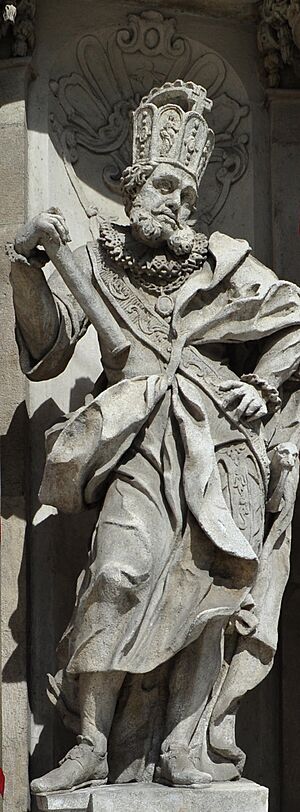
The main ruling family of Bohemia and Moravia, the Přemyslids, ended in 1306. Then, in 1310, John of Luxembourg became the Margrave of Moravia and King of Bohemia. His son, Charles IV, later became Margrave and then King. Charles gave Moravia to his younger brother, John Henry, who ruled until 1375.
After John Henry, his son Jobst of Moravia took over. Jobst was so important that he was even elected as the Holy Roman King in 1410, but he died shortly after. He and his father are buried in the Church of St. Thomas in Brno, which was the capital of Moravia.
Moravia and Bohemia stayed together under the Luxembourg family for a long time. This changed in 1437 when Albert II of Habsburg inherited them.
After Albert's death, there was a period without a clear king. Then, in 1458, George of Poděbrady was elected king. He brought all the Czech lands, including Moravia, back under one ruler. However, in 1466, the Pope told Catholics not to support George. This led to a war, and in 1469, Matthias Corvinus of Hungary conquered Moravia. He even claimed to be the King of Bohemia.
This period of a divided kingdom, lasting 21 years, helped Moravians feel like they had their own special identity, separate from Bohemia. Even when Moravia and Bohemia were reunited in 1490 under Vladislaus Jagiellon, Moravians still valued their "freedoms" and sometimes resisted rule from Prague. In 1526, Vladislaus's son died in battle, and Ferdinand I of the Habsburg family was chosen as the new ruler.
Habsburg Rule (1526–1918)
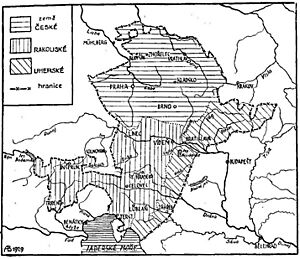
From 1526 to 1620, there was growing tension between the Catholic Habsburg kings and the Protestant nobles in Moravia. Moravia, like Bohemia, remained under Habsburg rule until the end of World War I.
In 1573, the Jesuits founded the University of Olomouc. This was the first university in Moravia. It became an important center for spreading Catholicism in Central and Northern Europe. Many students from Scandinavia even came to study there.
Until 1641, both Brno and Olomouc were capitals of Moravia. But after Swedish forces captured Olomouc, Brno became the only capital. Brno was the only city in Moravia that successfully fought off the invaders.
Moravia had its own parliament, called the zemský sněm (or Landtag). From 1905, people elected representatives to this parliament separately, based on whether they were Czech or German.
In the 17th century, the Reduta Theatre was built in Moravia. It is one of the oldest theater buildings in Central Europe today. In 1740, Prussian forces invaded Moravia. They besieged Olomouc again in 1758, but the defenders of Olomouc forced them to leave after a battle.
In 1777, a new bishopric (a church district led by a bishop) was created in Brno. The Olomouc bishopric was made an archbishopric (a higher church district). In 1782, Moravia was joined with Austrian Silesia to form "Moravia-Silesia," with Brno as its capital. This lasted until 1850.
Moravia in the 20th Century
After the huge Austro-Hungarian Empire broke apart in 1918, Moravia became part of a new country called Czechoslovakia. Moravia had some freedom, but it was limited.
In 1928, Moravia changed again. It was combined with Czech Silesia to form the Moravian–Silesian Land. During World War II, when Germany occupied Czechoslovakia, Moravia was divided. Part of it became an administrative unit within the German-controlled Protectorate of Bohemia and Moravia. Areas with more ethnic Germans were taken directly by Germany.
After World War II ended in 1945, Czechoslovakia expelled many ethnic Germans from Moravia. The Moravian–Silesian Land was brought back. However, in 1949, Czechoslovakia changed its internal borders. The Moravian-Silesian Land was abolished. Instead, the country was divided into new "regions" called kraje. These new borders did not follow the old historical lines of Bohemia and Moravia. This meant that Moravia, as a political area, officially stopped existing after about 1116 years of history.
After the Soviet Union fell, the Czechoslovak parliament said that the cancellation of the Moravian–Silesian land was wrong. They hoped this "injustice will be corrected" in 1990. But when Czechoslovakia split into the Czech Republic and Slovakia in 1993, Moravia remained part of the Czech Republic. The latest administrative divisions of the Czech Republic, set up in 2000, are very similar to the 1949 divisions.
Images for kids


